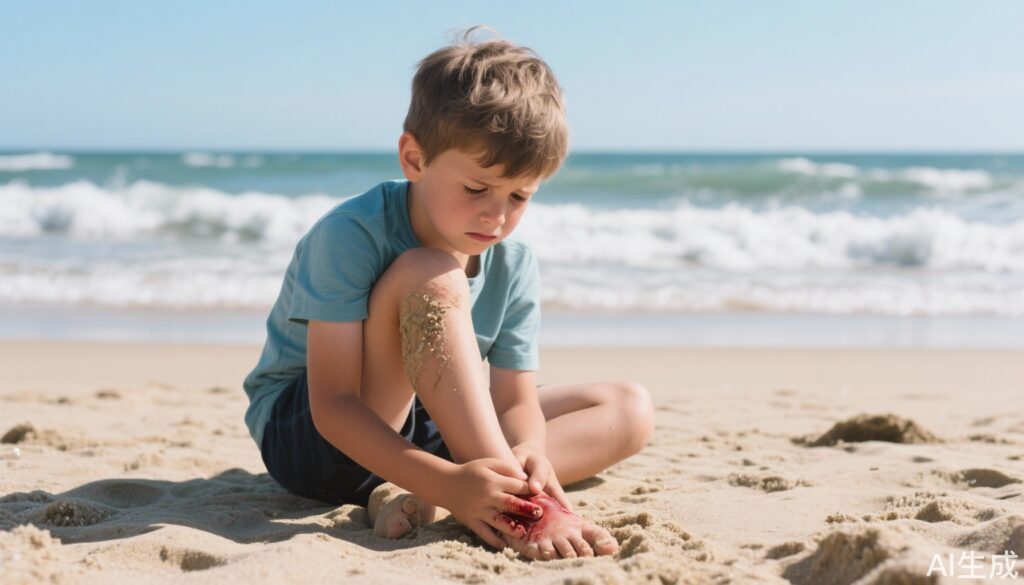Introduction: A Summer Beach Day Turns Critical
On a sunny day in Xiamen, Fujian Province, a six-year-old boy was playing barefoot on the beach when he unknowingly stepped on a dead fish. The fish’s fin punctured his foot, leaving behind what seemed like a minor scratch — a small wound that his parents initially did not consider dangerous. However, within 24 hours, the boy developed severe symptoms, including vomiting and a high fever, prompting urgent hospitalization in the intensive care unit of Xiamen University’s First Affiliated Hospital. Medical examination revealed infection with Vibrio vulnificus, a deadly marine bacterium also known as the “ocean assassin.” Timely surgical removal of necrotic tissue and antibiotic therapy saved the boy’s foot and life, but the case serves as a stark reminder of a hidden danger lurking behind the joys of sun, sand, and seafood.
What is Vibrio vulnificus? The “Ocean Assassin”
Vibrio vulnificus is a halophilic (salt-loving) bacterium naturally found in warm marine and estuarine environments such as coastal waters. It commonly colonizes marine life like fish, shrimp, and crabs, especially around their fins and tails, which are sharp and prone to causing skin injuries. While usually harmless to healthy individuals when contained, the bacterium can cause devastating infections if it gains entry through skin wounds or is ingested through undercooked or raw seafood.
This bacterium is notorious for its rapid progression to severe tissue necrosis and sepsis. Certain strains have been called “ocean assassins” due to their ability to cause death in a matter of days if untreated. In severe cases, surgical amputation is often necessary to halt the infection’s spread and save a patient’s life.
Modes of Infection: How Does Vibrio vulnificus Enter the Body?
There are primarily two routes for humans to become infected:
1. Wound infection: When a person has an open cut or abrasion on the skin and is exposed to Vibrio-contaminated seawater or marine animals, the bacteria can enter and trigger infection.
2. Foodborne infection: Consuming raw or undercooked seafood, particularly oysters or other shellfish contaminated with Vibrio vulnificus, can lead to gastrointestinal illness and potentially systemic infection.
Recognizing Symptoms of Vibrio vulnificus Infection
Once infected, symptoms can vary depending on the infection route and individual susceptibility. They generally fall into three categories:
– Gastrointestinal illness: Following consumption of contaminated seafood, symptoms such as diarrhea and abdominal cramps manifest.
– Septicemia: This severe bloodstream infection, often following seafood consumption, can cause fever, chills, and skin lesions. It poses high mortality risk, especially in individuals with underlying diseases.
– Wound infections: These begin rapidly at the injury site with redness, swelling, severe pain, warmth, and blistering. Without swift treatment, the infection can destroy skin and muscle leading to necrotizing fasciitis with a mortality rate exceeding 50%.
Clinical Management and Treatment Strategies
Immediate medical attention is critical for suspected Vibrio vulnificus infections. Key interventions include:
– Wound care: Prompt and thorough cleansing of wounds with clean water (not saline, which may worsen infection) and removal of any foreign material or dead tissue.
– Antibiotics: Early empirical administration of effective antimicrobials targeting Vibrio vulnificus is essential.
– Surgery: In cases of severe soft tissue destruction, surgical debridement or even amputation may be necessary to save life.
– Supportive care: Management in intensive care may be needed for systemic infection and organ support.
Common Misconceptions and Risky Behaviors
Many people underestimate the risk of minor wounds on beach excursions or handling seafood. Common misconceptions include:
– Believing small wounds do not require medical attention.
– Using saline solution or seawater to rinse wounds, which can exacerbate the bacterial colonization.
– Consuming raw or undercooked seafood without awareness of infection risk.
Ignoring early symptoms such as pain, redness, or fever can delay treatment leading to catastrophic outcomes, including limb loss or death.
Preventive Measures for Safe Beach and Seafood Experiences
To minimize risks posed by Vibrio vulnificus:
– Avoid walking barefoot on the beach, especially near dead fish or sharp marine debris.
– Wear gloves when handling seafood to prevent punctures or cuts.
– Do not consume raw or undercooked shellfish and fish; ensure seafood is thoroughly cooked.
– If injured by marine animals or contaminated water, immediately wash wounds with clean freshwater, avoid saline rinsing, and seek prompt medical care.
– Monitor wounds closely for worsening signs and systemic symptoms.
Geographical and Susceptibility Considerations
Vibrio vulnificus thrives in temperate to subtropical coastal waters, notably in China’s Zhejiang, Fujian, Guangdong, and Guangxi regions, as well as similar environments worldwide. While healthy individuals may resist infection, vulnerable populations face increased risk. These include:
– People with chronic liver diseases
– Diabetics
– Individuals with weakened immune systems, including those on immunosuppressive therapy
– Those with alcoholism or other significant health impairments
Such groups must exercise extra caution in marine settings and dietary choices.
Expert Insights
Dr. Wang Chuanlin, Chief Emergency Surgeon at Peking University People’s Hospital, advises: “While ordinary healthy individuals generally have solid defenses against Vibrio vulnificus, people with underlying conditions such as hepatitis, diabetes, or compromised immunity face a heightened risk. It is vital for these people to exercise preventative measures diligently. Early warning signs should never be ignored to prevent rapid disease progression.”
A Fictional Patient Scenario: Emily’s Story
Emily, an eight-year-old girl visiting a coastal town, stepped on a crab shell while running barefoot on the beach. The cut initially seemed trivial, and she continued playing. Within hours, her ankle became red and swollen, and she developed a fever. Her parents sought medical attention immediately, where doctors diagnosed a Vibrio vulnificus wound infection. Thanks to timely surgical and antibiotic treatment, Emily avoided amputation and made a full recovery. Her story highlights the importance of vigilance for even minor injuries in marine environments.
Conclusion: Balancing Enjoyment and Caution at the Seashore
Vibrio vulnificus infection is a rare but potentially deadly marine disease that demands awareness and readiness. Understanding the risks posed by marine wounds and raw seafood can prevent unnecessary suffering. Simple precautions such as proper wound care, avoiding raw seafood, and seeking early medical care represent the best defenses. Coastal visitors and seafood lovers can continue to enjoy sunshine, sand, and sea safely by staying informed and prepared.
References
1. Horseman MA, Surani S. A Comprehensive Review of Vibrio vulnificus: An Important Cause of Severe Sepsis and Skin and Soft-Tissue Infection. Int J Infect Dis. 2011;15(3):e157-e166.
2. Centers for Disease Control and Prevention (CDC). Vibrio vulnificus Infection. https://www.cdc.gov/vibrio/index.html
3. Wang C, Wang SS, Mou FF et al. Epidemiology and Clinical Characteristics of Vibrio vulnificus Infection in Southeastern Coastal China: A Retrospective Study. J Clin Microbiol. 2020;58(8):e01451-19.
4. Oliver JD. Wound Infections Caused by Vibrio vulnificus and Other Marine Bacteria. Epidemiol Infect. 2005;133(3):383-391.
5. Xiamen University First Affiliated Hospital Official Reports on Vibrio vulnificus Cases. (2024).


